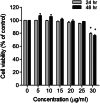Antibacterial and antioxidant effect of ethanol extracts of Terminalia chebula on Streptococcus mutans
- PMID: 34184430
- PMCID: PMC8638286
- DOI: 10.1002/cre2.467
Antibacterial and antioxidant effect of ethanol extracts of Terminalia chebula on Streptococcus mutans
Abstract
Objective: Dental caries is a high prevalent chronic bacterial infectious disease caused by plaque, a bacterial colony deposited on tooth surfaces and gum tissues. Streptococcus mutans is a primary cariogenic bacterium commonly found in the human oral cavity. Oral hygiene products containing antibacterial ingredients can be helpful in caries management. In this study, we investigated the anticaries mechanism of the ethanol extract of Terminalia chebula (EETC) on S. mutans and suggest its possible application as a functional ingredients for oral hygiene products.
Materials and methods: The EETC was prepared from the Terminalia chebula fruit. Disk diffusion, minimum inhibitory concentration (MIC), minimum bactericidal concentration (MBC), and colony forming unit (CFU) were analyzed to observe the antibacterial activity of EETC. The glucan formation was measured using the filtrate of bacterial culture medium and sucrose. Gene expression was analyzed using RT-PCR. Cytotoxicity was analyzed using the MTT assay. The radical-scavenging activities of DPPH and ABTS were also tested to verify the antioxidant activity of EETC.
Results: The antibacterial activity of the EETC was explored through a disc diffusion analysis and CFU measurement. EETC treatment decreased insoluble glucan formation and gene expression of glycosyltransferase B (gtf B), glycosyltransferase C (gtf C), glycosyltransferase D (gtf D), and fructosyltransferase (ftf). The MIC and MBC of EETC on S. mutans were not cytotoxic to gingival fibroblasts. In addition, we observed DPPH and ABTS-radical scavenging activities of EETC.
Conclusions: These results indicate that the antibacterial and antioxidant effects of EETC may contribute to oral hygiene products for dental caries management.
Keywords: Streptococcus mutans; dental caries; ethanol extract of Terminalia chebula; plaque.
© 2021 The Authors. Clinical and Experimental Dental Research published by John Wiley & Sons Ltd.
Conflict of interest statement
The authors have no conflict of interest to disclose.
Figures




References
-
- Brand‐williams, W. , Cuvelier, M. E. , & Berset, C. (1995). Use of a free radical method to evaluate antioxidant activity. LWT‐Food Science and Technology, 28(1), 25–30.
-
- Caufield, P. W. (2005). Dental caries: An infectious and transmissible disease where have we been and where are we going? The New York State Dental Journal, 71(2), 23–27. - PubMed
-
- Duchin, S. , & van Houte, J. (1978). Relationship of Streptococcus mutans and lactobacilli to incipient smooth surface dental caries in man. Archives of Oral Biology, 23(9), 779–786. - PubMed
-
- Fujishima, K. , Kawada‐Matsuo, M. , Oogai, Y. , Tokuda, M. , Torii, M. , & Komatsuzawa, H. (2013). dpr and sod in Streptococcus mutans are involved in coexistence with S. sanguinis, and PerR is associated with resistance to H2O2 . Applied and Environmental Microbiology, 79(5), 1436–1443. - PMC - PubMed
Publication types
MeSH terms
Substances
LinkOut - more resources
Full Text Sources
Medical

